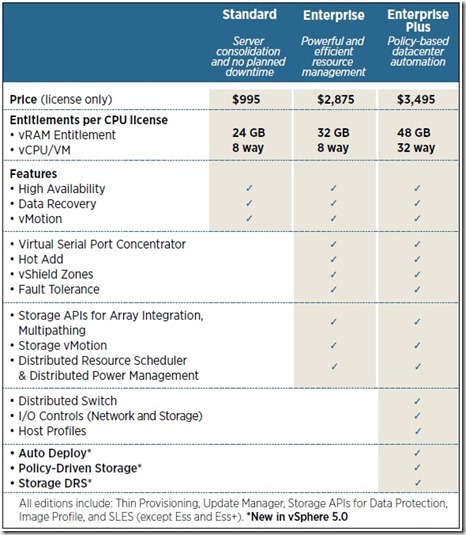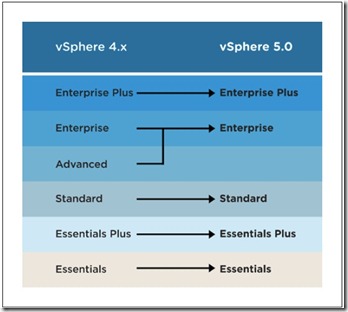Category Archives: ESXi5
vSphere 5 Details–What’s New
I imagine this will be the title of a thousand blog posts from now through July and August, but here goes…
Check out the VMware ‘What’s New’ Guide Here
Check out Virtual Geek’s Blog Here and the excellent Yellow Bricks Here
vSphere 5 Details–Licensing
UPDATE – vRAM Entitlements have now been revised – please see this post
Licensing – WTH are ‘Pooled RAM Entitlements’?
VMware are narrowing down the version choices in vSphere 5 and changing the model (Slightly), rather than being just based around a single CPU with a maximum number of cores (as per version 4.x), version 5 has a licensing model they describe as per processor (CPU) with pooled vRAM entitlements.
VMware claim the new method is safer and fairer – but we are not convinced, since nahalem removed the need for lots of CPU’s and made memory king many virtual environments have been decreasing CPU requirements over the last 18 months. I have been involved in two projects that have halved the numbers of CPUs in each environment whilst quadrupling the RAM. VMware are filling this gap by removing the core restrictions from each ‘per-CPU’ license, but (depending on the version you are buying) allowing you a restricted amount of RAM per license. They are being flexible as this vRAM can be placed anywhere on hosts connected to your vCenter instance.
To be clear you are no longer restricted on how many cores or how much physical RAM you have on an installation of vSphere 5, but each CPU license will allocate an amount of vRAM into your vRAM pool.
So the important question is ‘What is the ‘entitlement’ PER PROCESSOR for the various editions that I can add into my Pool of RAM:
Entitlement by vSphere edition
– 8GB vRAM for vSphere Hypervisor Based on ESXi (FREE Edition)
– 24GB vRAM for Essentials Kit
– 24GB vRAM for Essentials Plus Kit
– 24GB vRAM for Standard
– 32GB vRAM for Enterprise
– 48GB vRAM for Enterprise Plus
So on the surface, this looks quite healthy, HOWEVER, you need to be aware that this is based on allocated vRAM to virtual machines, NOT physical RAM, so the model begins to look a little more challenging. As blog reader Colin Dunn pointed out and in line with the above comments, memory is now king in the virtual world and most typical nodes in an enterprise will be dual (hex-core) processors and 128GB+ of RAM, to commit all of this and over-subscribe by a modest 10% would consume 144GB of Pool vRAM Entitlement. So in the new world an over-subscribed host would now consume THREE Processors worth of licensing on a host that would previously have only required TWO. This is of course balanced against those environments where utilisation is low, but the fact remains.
More Details on Licensing Pricing and Packaging Can be Found at THIS VMware Whitepaper
For Upgraders also visit the following URL – http://www.vmware.com/products/vsphere/upgrade-center/licensing.html
VMware vSphere 5– Editions
Versions – Bye Bye ‘Advanced’
VMware have simplified the versions of vSphere in version 5 slightly, gone is the Advanced edition (upgraders skip straight to Enterprise – may be worth getting as many Advanced Licences as you can now!).
Essentials Kits
VMware have retained the Essentials Kits – which will be a relief to a lot of our SME and Education clients and those SKU’s retain the model of ‘up to 6 processors’ and ‘up to 2 processors per host’, they have a vRAM entitlement of 24GB per processor, which automatically means a Pooled vRAM Entitlement of 144GB of vRAM allocated to virtual machines. (See this post if the above seems like gibberish to you).
The differences between Essentials and Essentials PLUS remain the same (essentials gives you a vCenter and the vStorage API to backup running VMs, Essentials PLUS adds HA, DRS and vSphere Data Recovery).
VMware also continue to provide the Essentials Kit for Retail and Branch Offices – little used and little cared for!
Regular SKU’s
Aside from the removal of the little-used ‘Advanced’ SKU, things have not changed massively in the regular product SKU’s. We are now reduced to a simpler provision of Standard, Enterprise and Enterprise PLUS. Ent PLUS now becomes the default offering for the Cloud provider to take advantage of new vSphere 5 features of Auto Deploy, Storage DRS and Policy-Driven Storage and for the new feature in VMware v8 VM’s of 32 way processors.
The table below illustrates the high level differences and the RRP against each SKU:
Acceleration Kits
Think ‘Essentials’ for Grown Ups!
Acceleration Kits are a neat way to convert enterprise customers to VMware at a good starting price-point, essentially they offer a very aggressively packaged collection of CPU licences to commence an installation in organisations that STILL have no VMware environment (we know, there are still some strange folk out there, perhaps they’ve been playing with that Hyper-V rubbish!). Anyway, procured intelligently, these can save a LOT of money when aligned with the right hardware. An overview table is included below:
Upgrading
Finally on this subject is upgrading from vSphere 4-5, there is a very simple map between the product versions that can be seen in the diagram below:
Entitled to an upgrade are all users with support on licenses at the time of GA (General Availability) of vSphere 5 – there is no official word on GA at present, but VMworld 2011 is happening on 29th August in Vegas – wouldn’t that be a great place to launch!
I URGE YOU TO READ THE WHITEPAPER BELOW WHICH IS THE SOURCE OF MUCH OF THIS MATERIAL
More Details on Licensing Pricing and Packaging Can be Found at THIS VMware Whitepaper
For Upgraders also visit the following URL – http://www.vmware.com/products/vsphere/upgrade-center/licensing.html
VMware ESXi 5.0 Rumours/Details
Virtualization.info is reporting on a post from turkish forums reporting details of ESXi5.0, you can take most of them with a pinch of salt, but some will almost certainly feature – I will post an update with bets as to which features are nailed on and which are unlikely very soon. Their post in full…
In February this year, virtualization.info reported about VMware which exposed some of the upcoming features of vSphere 5 during its Partner Exchange. Last week even more details appeared online, these details leaked on a Turkish Web Forum, but were removed later. The post itself can still be retrieved from Google Cache though.
Besides, Distributed Resource Scheduling (DRS) for Storage, Host-based replication for Site Recovery Manager, and Network I/O control for Virtual Machines, vSphere 5 will feature:
- Build on the vSphere ESXi hypervisor architecture
- vSphere Auto Deploy combining host profiles, Image Builder and PXE
- Unified CLI framework, allowing consistency of authentication, roles and auditing.
- Support for up to 1 TB of memory
- Support for 32 vCPU’s per VM
- Nonhardware accelerated 3D graphics for Windows Aero support
- USB 3.0 device support
- UEFI virtual BIOS
- Host EUFI boot support
- New GUI to configure multicore vCPUs
- Client-connected USB devices
- Smart card reader support for VMs
- Apple Mac OS X Server 10.6 (Snow Leopard) guest OS support
- Support for up to 512 VMs
- Support for up to 160 Logical CPUs and 2 TB or RAM
- Improved SNMP support
- Storage driven storage delivery based on the VMware-Aware Storage APIs
- Improved version of the Cluster File System, VMFS5
- Accelerator for specific use with View (VDI) workloads, providing a read cache optimized for recognizing, handling and deduplicating VDI client images.
- iSCSI user interface support
- Storage APIs – Array Integration: Thin Provisioning enabling reclaiming blocks of a thin provisioned LUN on the array when a virtual disk is deleted
- Swap to SSD
- 2TB+ LUN support
- Storage vMotion snapshot support
- vNetwork Distributed Switch improvements providing improved visibility in VM traffic
- ESXi Firewall protecting the ESXi 5.0 management interface
- A browser-based, fully-extensible, platform-independent implementation of the vSphere Client based on Adobe Flex.
- vCenter Server Appliance
- Inventory Extensibility: providing a manager to monitor partner extensions.
- vCenter Solutions Manager, providing a consistent interface to configure and monitor vCenter-integrated solutions developed by VMware and third parties.
- System message logging enhancements
- Revamped VMware High Availability (HA) with Fault Domain Manager
- All hosts in cluster can be primary nodes
- Cluster also uses shared storage as a channel for heartbeat detection
Thanks to Techtarget for providing the news



